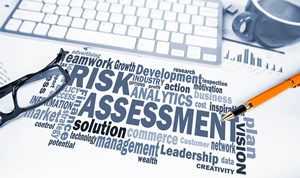Risk. It’s something organizations and their employees encounter on a daily basis. How they approach risk can mean the difference between a safe work environment and serious injuries and fatalities (SIFs).

How risk is viewed by both safety professionals and business executives has evolved over time, and in recent years become more of a focus for improving safety performance. For many decades in occupational safety and health, businesses around the world were more focused on regulatory compliance than managing risks. As time went on and illnesses, injuries and fatalities metrics plateaued, it was clear that something needed to change in order to achieve real progress.
“People began to see that they were meeting compliance requirements in most cases and performance wasn’t improving, so something else was needed,” says Ken Daigle, vice president of safety management at BP and chair of the ASSP Risk Assessment Institute. “They recognized that taking a risk-based approach was something that would lead to real change in performance improvement.”
In the late 1990s and early 2000s, organizations in the U.S. and throughout the world began to shift toward more risk-based decision-making to improve overall safety performance and reduced incidents of SIFs. This was coupled with the fact that regulators in certain regions began adopting more risk-based approaches.
“Faced with constrained resources and economic challenges, organizations realized that a risk-based approach is more practical from a business standpoint as well,” explains Daigle. “Employing a risk-based strategy provides the opportunity to leverage business performance and allows companies to put money, efforts and resources toward the greatest risks.”
A risk-based strategy serves many purposes, the foremost of which is identifying potential hazards and risks associated with an operation so that proper controls can be put in place. Once the risk is understood, organizations can develop a number of options for mitigating or eliminating hazards and risks. Safety professionals can play a key role in the process if they are able to facilitate the analysis and identify practical solutions.
“The value of risk assessment is in the discussion that it fosters between executives and safety professionals,” says Daigle. “Risk assessment as a concept and as a tool is very flexible in being able to help both groups make better decisions.”
A properly designed risk assessment will also effectively communicate to decision-makers the impact these risks could have on the organization, both from a safety standpoint and on the bottom line.
Although progress has been made among safety professionals and business executives in utilizing risk-based decision-making, many are still along the continuum of maturity from compliance to improved performance through risk assessment. To this day, the level of expertise about risk assessment and how risk is viewed varies from region to region.
Furthermore, data from the Bureau of Labor Statistics shows that, from 2003 to 2016, the level of fatal occupational injuries maintained relatively steady. This indicates that there is still more work to do to educate safety professionals and business executives on the importance of identifying hazards and how risk assessment can help deliver that next step change in safety performance.
That’s where the Risk Assessment Institute comes in. Since its inception in 2013, the institute has helped ASSE provide safety professionals with risk assessment tools, education, training and awareness, and helped C-suite executives and business people make better safety decisions.
“The way an organization applies risk assessment may differ, but the concepts remain the same,” explains Daigle. “If businesses apply risk assessment concepts consistently and systematically, they can begin to improve their safety performance and, in turn, their business performance.”
Looking to the future, Daigle says a top priority for ASSE is to expand into other areas of education and training for both safety professionals and business executives. First and foremost is training safety professionals on facilitating the risk assessment process and communicating the results.
Although many safety professionals are comfortable with and adept at assessing and calculating risks, the challenge lies in effectively communicating those risks to executives and decision-makers within their organizations.
“Moving forward, the next step is to help safety professionals better communicate the results of risk assessments and help business people see why having these tools will add value to the business,” says Daigle. “If you can put risk in terms of dollars, that’s the easiest metric to use to convince executives to address those risks.”
The second element is training executives and business leaders on how to use the information gathered from a risk assessment. While individuals in these positions may not need to know the details of how to conduct a risk assessment, make calculations and apply the concepts, they do need to understand how the information was acquired, what to do with the output and what the outcome will be.
“It’s important for executives to understand why having a safety professional in the organization who is skilled at applying these concepts is a real benefit to them,” says Daigle. “Safety professionals are not just there for compliance, they add to the bottom line.”
Daigle’s hope is that safety professionals will gain a greater understanding of the role risk assessments play in safety improvement, and that business executives will learn the benefits that safety professionals and risk assessment can provide to an organization.
“It comes down to a decision,” says Daigle, “for organizations to choose to make better safety decisions by applying risk concepts.”
Related Links
Communicating and Managing Risk: The Key Result of Risk Assessment
Rightsizing Risk Management for Small & Medium Enterprises
Corrective Actions: Strengthening Safety by Addressing At-Risk Behavior
Managing Risk Perceptions: Safety Program Support Outcomes